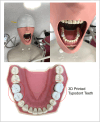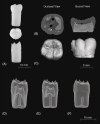An evaluation by dental clinicians of cutting characteristics and haptic perceptions in 3D-printed typodont teeth: A pilot study
- PMID: 39444145
- PMCID: PMC12004343
- DOI: 10.1002/jdd.13749
An evaluation by dental clinicians of cutting characteristics and haptic perceptions in 3D-printed typodont teeth: A pilot study
Abstract
Objectives: This study aimed to compare the haptic perception of clinicians to the cutting response of 3D-printed typodont teeth and commercial typodont teeth and human extracted teeth.
Methods: Twenty clinicians were asked to perform a Class I cavity preparation on commercial typodont teeth, 3D-printed typodont teeth, and human extracted teeth, while the forces were recorded via a three-axis load cell. The haptic perception of clinicians was also evaluated through a response questionnaire comparing commercial and 3D-printed typodont teeth.
Results: The study found that clinicians used similar forces (p = 0.53) to cut both the 3D-printed typodont teeth (1.37 N) and the human extracted teeth (1.44 N), but more force was needed to cut the commercial typodont teeth (3.71 N). The response questionnaire indicated that clinicians rated the 3D-printed typodont teeth highly compared to the commercial teeth. The 3D-printed dentine received favorable feedback from clinicians, and the 3D-printed enamel was rated higher compared to the commercial equivalents.
Conclusions: The results of the study suggest that 3D-printed typodont teeth offer a comparable haptic perception to human extracted teeth and can be used as an effective tool for preclinical dental learning. Moreover, the study highlights the advantages of 3D-printed typodont teeth over commercial typodont teeth in terms of haptic perception.
Keywords: 3D printing; dental education; haptic perception; operative; preclinical training; simulation‐based medical education.
© 2024 The Author(s). Journal of Dental Education published by Wiley Periodicals LLC on behalf of American Dental Education Association.
Conflict of interest statement
The authors declare no conflicts of interest.
Figures






Similar articles
-
Composite 3D printing of biomimetic human teeth.Sci Rep. 2022 May 12;12(1):7830. doi: 10.1038/s41598-022-11658-y. Sci Rep. 2022. PMID: 35550557 Free PMC article.
-
Students' perceptions of endodontic typodont teeth with simulated canals printed from novel materials.Front Dent Med. 2024 Jun 14;5:1373922. doi: 10.3389/fdmed.2024.1373922. eCollection 2024. Front Dent Med. 2024. PMID: 39917701 Free PMC article.
-
Effect of 3D printed teeth and virtual simulation system on the pre-clinical access cavity preparation training of senior dental undergraduates.BMC Med Educ. 2024 Aug 23;24(1):913. doi: 10.1186/s12909-024-05869-2. BMC Med Educ. 2024. PMID: 39180072 Free PMC article.
-
Application of 3D-printed teeth models in teaching dentistry students: A scoping review.Eur J Dent Educ. 2023 Feb;27(1):126-134. doi: 10.1111/eje.12784. Epub 2022 Feb 10. Eur J Dent Educ. 2023. PMID: 35108452
-
Applications of 3D-printed teeth in dental education: A narrative review.J Taibah Univ Med Sci. 2024 Aug 1;19(4):816-822. doi: 10.1016/j.jtumed.2024.07.005. eCollection 2024 Aug. J Taibah Univ Med Sci. 2024. PMID: 39220120 Free PMC article. Review.
Cited by
-
Innovative 3D-printed educational models for vital pulp treatments and local anesthesia training in pediatric dentistry.BMC Med Educ. 2025 Jul 28;25(1):1122. doi: 10.1186/s12909-025-07701-x. BMC Med Educ. 2025. PMID: 40721765 Free PMC article.
-
Student's Perception Towards Endodontic Training with Artificial Teeth: What Has Changed?Eur Endod J. 2025 Jul;10(4):270-277. doi: 10.14744/eej.2025.95867. Eur Endod J. 2025. PMID: 40705452 Free PMC article.
References
-
- O'Brien EK, Wayne DB, Barsness KA, McGaghie WC, Barsuk JH. Use of 3D printing for medical education models in transplantation medicine: a critical review. Curr Transplant Rep. 2016;3:109‐119.
-
- Swanwick T, Forrest K, O'Brien BC. Understanding Medical Education: Evidence, Theory, and Practice. Wiley Blackwell; 2018.
MeSH terms
Grants and funding
LinkOut - more resources
Full Text Sources

